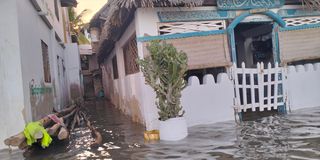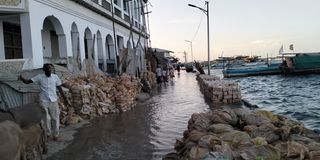Climate change or seasonal pattern? Record flooding hits Lamu Old Town
What you need to know:
- Lamu County Meteorological Services Director, Ngao Leli, noted that a change in ocean behaviour causes flooding in most areas along the coastline, Lamu included.
- The ocean behavior changes, he said, are linked to the gravitational attraction of the, resulting in high or low tides.
- “People should know that the gravitational attraction of the moon always creates high and low tides.
Business in Lamu Old Town came to a standstill on Monday evening and for the better part of Tuesday morning after shops, houses, and streets were submerged when the Indian Ocean experienced unprecedented high tides, leading to backflow.
Lamu is a Unesco World Heritage site, having been listed in 2001.
Locals faced it rough after the Indian Ocean overflowed, pouring its water into residential and business places.
Some traders were displaced when the seafront area of Lamu Old Town was completely flooded and rendered impassable for donkeys, carts, and even for those with motorcycles.
The floods forced residents and tourists visiting the archipelago to find alternative and long routes, deep inside the historical city, to reach their destinations.
Environmentalists interviewed by Nation.Africa said despite the Indian Ocean flooding Lamu annually, the Monday flood waters reached unprecedented levels.
Last year, the Lamu County government intervened and raised the seawalls in Old Town yet the water managed to overflow and wreak havoc.
Lamu Marine Forum Chairman, Mohamed Athman, attributed the increased water levels at sea to global warming and climate change.

business place flooded by Indian Ocean water in Lamu Old Town on March 31,2025.
“I am not shocked. This truly depicts the adverse effects of climate change. People have continued to destroy mangroves, which are key to the existence of our coastal ecosystems. They should now be ready for such consequences,” said Mr Athman.
“Global warming and the world’s general temperature rise as a result of climate change is also part of what we’re witnessing in Lamu at the moment.
Global warming always results in sea level rise, primarily driven by the thermal expansion of water as the oceans warm, and the melting of glaciers and ice sheets, which adds more water to the oceans.”
Mr Nasoro Mahfudh, an environmental activist in Lamu, also linked the Lamu Old Town flooding to climate change.
Mr Mahfudh explained that oceans also absorb large amounts of heat, leading to the expansion of the vast water bodies.
“This warming causes water to expand in volume, a process known as thermal expansion, which contributes to rising sea levels. We, therefore, need to take care of our environment as coastal communities.
Let’s embrace planting more mangroves that will help to address the adverse effects of climate change,” said Mr Mahfudh.

A section of Lamu Island seafront flooded by Indian Ocean water.
Rising sea levels, he said, pose a significant threat to Lamu and coastal communities and ecosystems.
“That’s why in recent times, you’ll see our seawalls constructed afresh with others raised, yet within no time, you spot these infrastructures getting destroyed by seawater. All that is due to climate change,” said Mr Mahfudh.
Locals interviewed, however, said they were treating the flooding as a normal occurrence that happens during particular months of every year.
“This is normal. Though a bit uncomfortable, that doesn’t bother us. We know the situation will normalise in a matter of days,” said Ali Kombo, 52.

The Lamu Old Town main gate flooded by Indian Ocean waters on March 31, 2025.
Mohamed Yakub concurred: “And that’s why when you look around, you will see people on foot and cart handlers wading through the puddles of salty water from the Indian Ocean. The floods always die a natural death after a day or two. There’s nothing to worry about.”
Lamu County Meteorological Services Director, Ngao Leli, noted that a change in ocean behaviour causes flooding in most areas along the coastline, Lamu included.
The ocean behavior changes, he said, are linked to the gravitational attraction of the, resulting in high or low tides.
“People should know that the gravitational attraction of the moon always creates high and low tides.
Remember at the same time that there is the tidal range. This is the difference between the ocean level at high tide and the ocean at low tide. However, several factors influence the tidal range in every location,” said Mr Leli.
He further explained that ocean water in regions like Lamu always ends up overflowing to residential and business premises due to factors like the slope of the seafloor.
“Water always appears to move a greater distance on a gentle slope than on a steep slope. Lamu is low-lying and hence the flooding, which thereafter normalises as time goes by,” said Mr Leli.


